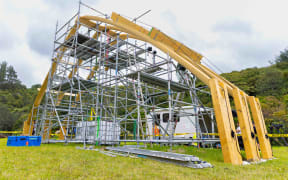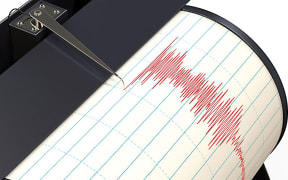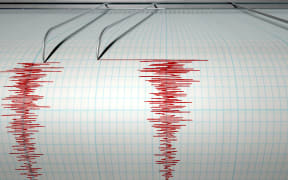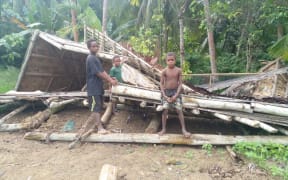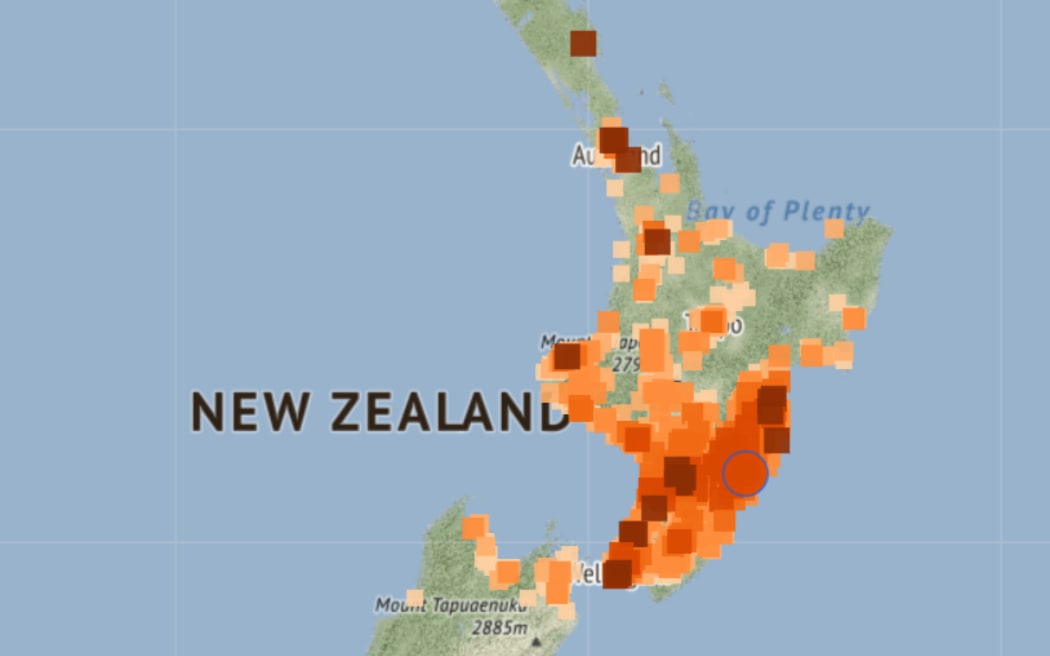
Reports of people feeling the Magnitude 5.9 quake on Wednesday morning. Photo: Supplied / GeoNet
Two strong earthquakes at a magnitude of 5.9 and 5.3 have struck near Pōrangahau in the lower North Island.
GeoNet said the first was the magnitude 5.9 which hit about 10.16am at a depth of 22km.
It was followed three minutes later by the magnitude 5.3 one, which was at a depth of 15km.
On GeoNet's website, about 22,000 people reported having felt the first and about 20,000 reported feeling the second.
The National Emergency Management Agency has confirmed there is no tsunami risk from the earthquakes.
A couple of dozen aftershocks have occurred since then, which was typical for an earthquake of this size, according to GeoNet. The largest aftershock was magnitude 4.3 that struck about 10.28am.
"Although that activity will wane with time, we do expect that there would be earthquakes that would be felt in the coming weeks and months following this event," GNS Science seismology project scientist Katie Jacobs said.
Farmer Gretchen King said they got a lot of earthquakes in the rural Hawke's Bay settlement, but this was the strongest one they had ever felt.
"It was fairly big, doors swinging, we've lost some pictures from walls, I think a few other things have fallen and hit the ground."
The earthquakes did not feel nearly as strong as those in Christchurch, but were big enough they felt they should take action, King said.
"It was enough to make us actually go and sit in the car, because we decided that having heard some of the terrible stories from Christchurch we didn't really want to hang around and wait inside with things falling about if we didn't have to."
There is no tsunami threat from the earthquake near Pōrangahau. We hope everyone is feeling okay.
— National Emergency Management Agency (@NZcivildefence) April 25, 2023
Remember, Drop, Cover and Hold is the right action to take in an earthquake. For more info or to lodge a felt report, visit https://t.co/S4g0uzEYHr
https://t.co/RRCkD5KITP
Central Hawke's Bay Mayor Alex Walker told Nine to Noon it was good to see people following safety guidance without waiting for official confirmation.
"I want to thank all of those that did self-evacuate on the message of 'if it's long and strong, get gone', and our community out there have taken that seriously."
The earthquakes had disturbed the community, which had already suffered damage from Cyclone Gabrielle earlier this year, Walker said.
"This is not the kind of wake up call we needed this morning. We do need to keep alert but what is happening in Pōrangahau at the moment is community spirit is relatively high.
"They're working together in their recovery from Cyclone Gabrielle, so their networks of how to connect together and look after [each other] as a community is particularly strong at the moment and council and Civil Defence will continue to wrap around them as we deal with it."
There had been reports of content damage inside properties, but they were not aware of any structural damage as of yet, Walker said.
"Our community there is also spread, we've got residential community who live in Whangaehu coastal community as well as our rural areas out there so we're just making sure we're getting a clear picture of what's happened on the ground, but everybody seems to be okay at the moment which is great."
GeoNet advised on its website that a landslide may be triggered by earthquakes, with homes near hills or steep slopes most at risk. If you live near a hill or steep slope, watch out for cracks or movement that could be a warning sign.
"If people need emergency help, they do need to ring 111 emergency services if they are in strife," Walker said.
Hikurangi subduction zone and slow-slip events
GNS Science seismology project scientist Katie Jacobs told Midday Report from Upper Hutt she also felt the earthquake.
"It was felt really strong throughout most of the lower North Island, with some reports going all the through the North Island and [upper] South Island."
While there was a fault system under Napier and Hastings, the Hikurangi subduction zone along the east coast of the North Island played a large part in earthquake behaviour in those regions, Jacobs said.
"We're actively trying to understand and study scientifically earthquakes, specifically in the Pōrangahau region.
"I'd also just like to give a shout out and thank you to people in the region who have been actively helping in the last couple of years by hosting additional earthquake recording equipment. A lot of the people who felt the event today will have been helping the science project in the last couple of years."
Pōrangahau was also a region that experienced slow-slip earthquakes, Jacobs said.
"Slow-slip events are the same kind of motion on the subduction zone like [what] would be experienced in a large earthquake, but instead of having that motion occur over seconds or minutes, like we have with this earthquake today [where] all that energy was released very quickly, in a slow-slip event that energy would be released over weeks to months," she said.
"So, it's not at a scale where anyone can feel it, and they can only be detected with quite sensitive GPS positioning equipment."
